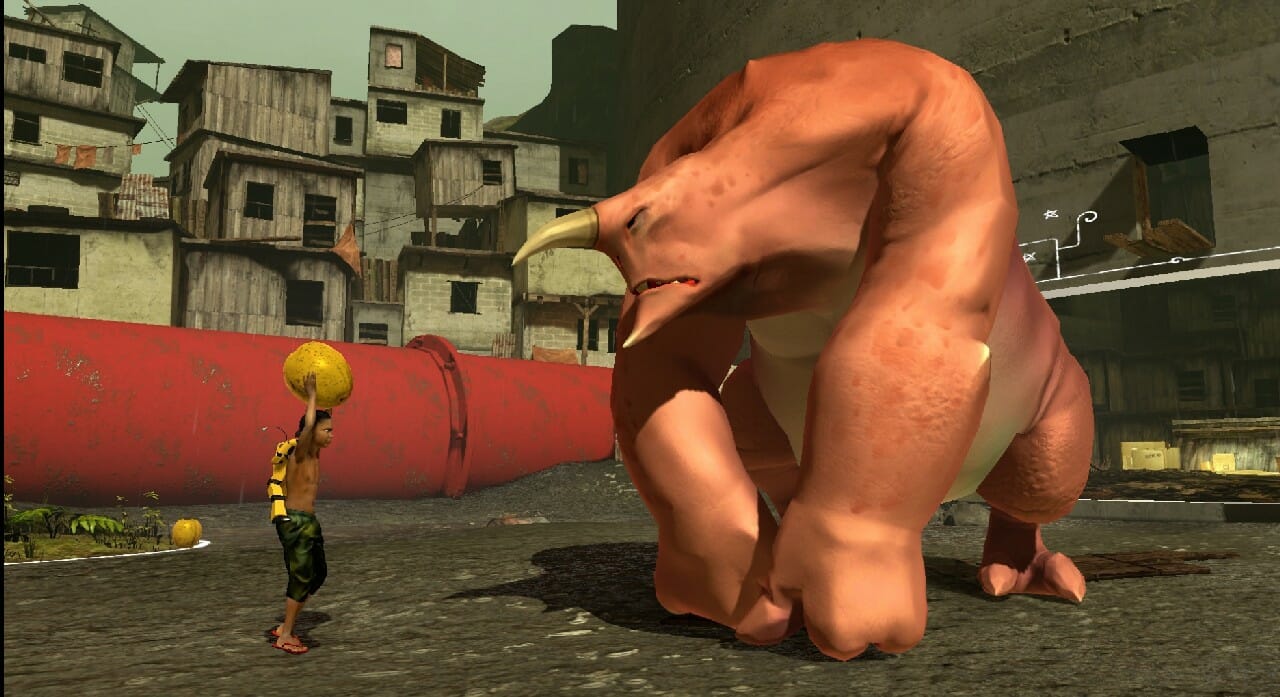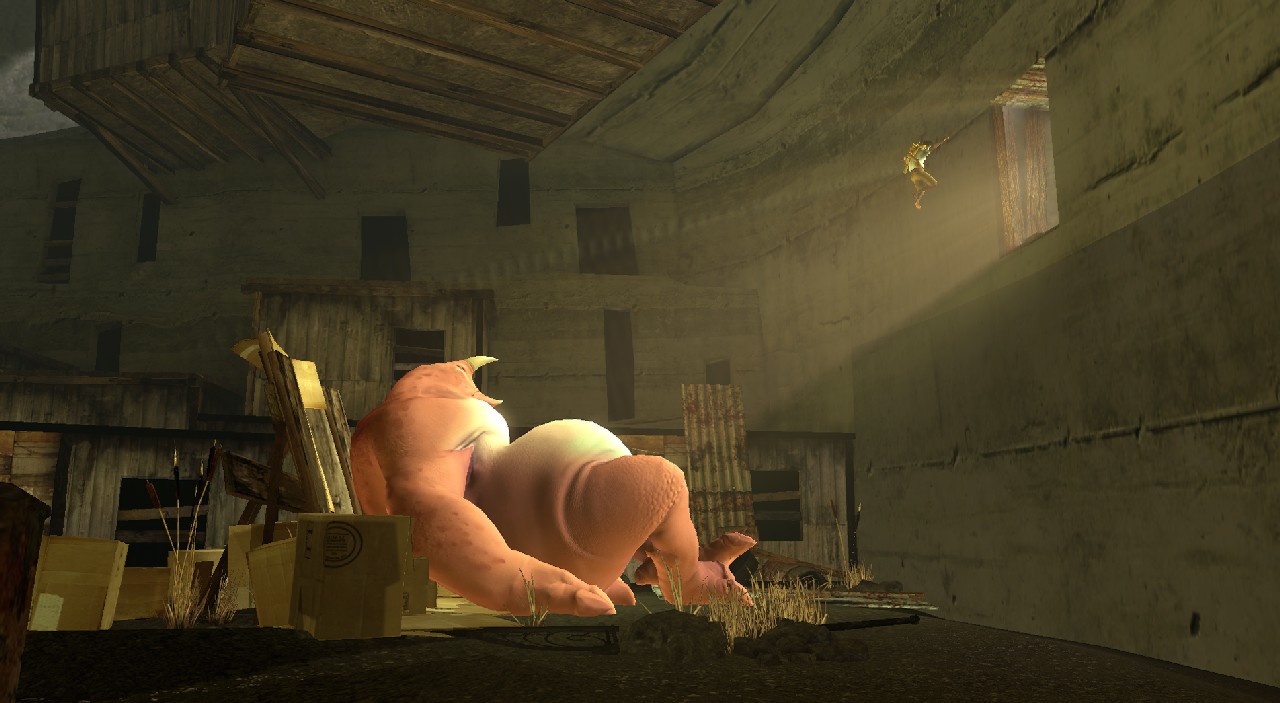
There is a kind of world-building that I think of as “Tolkienism”. It’s mythic and Catholic, based on mining canonical texts for meaning and avoiding contradictions in order to create internal consistency. Every effect has a cause: consistency in fiction is comforting. The largest “fictional worlds” we have are consistent because they’re the product of massive culture industries. And if they seem apolitical, it is likely because their politics are consistent with your unquestioned assumptions about the world. Internal consistency, consistency with your worldview: these are crucial for a fiction to be a tool for escapism. For most people, escapism can’t be unsettling.
Papo & Yo is unsettling. You’re a child, Quico, whose father is an alcoholic. Quico finds himself in the favela, chasing after a girl about his age who, shortly after meeting him, informs him that he is cursed. You’re on a quest to..well…you’re accompanied by your toy robot sidekick-slash-jetpack and a giant creature called Monster who, when he eats frogs, catches fire and attacks you.
The ground itself is unstable. As the architecture of the favela floats and folds, reshaping itself so that Quico can move forward, it feels like watching a child’s imagination at work. Or maybe like Inception, but with a soul—something more than just “hey, that’s cool!” The flouting of Euclidean space (one level is named “Euclid is wrong”), in a way that only videogames can, keeps you a little off balance, makes reality more ambiguous, maybe gets you thinking less literally, less linearly.
Once, early on, Quico falls through the ground. I angled the camera at the world above him, slowly shrinking into a circle of darkness. It took me a few seconds to realize that I was somewhere I wasn’t supposed to be, that I had glitched through the architecture.
There are a few reasons, I think, why games lend themselves so well to escapism. They engage our senses—not just sight and sound, but also our sense of direction, our sense of consequence. Systems tell us things are emergent. They create the future. They promise potential. And maybe they lie a little bit to get us to go along with it, hiding their fixed bits in source code that a machine translates for us. Everything we see about the game is procedurally generated from that fixed code. It’s ephemeral.
Tolkienism builds a world while denying it is created: a point of view is anathema to the objectivity of a reality that only exists on the page. An absent author, an objective space (by which I think I mean “a physics engine that reacts to our input”): these are crucial for exploring and understanding how a (ludo)(eco)system works. Trial and error only works if things are going to react consistently.
You’re given your actions early on (run, jump, send your robot pal to hit a switch, carry, throw, interact with magical chalk outlines). There’s no building of mechanics one onto the other, no surprising “oh ho!” moment where you realize the game taught you to use these basic skills in a way you never thought of until then.
Instead, the world is arbitrary. The magic works in whatever way it needs to in any given area. Quico is not mastering his world, discovering the rules that underpin it. He’s just getting by.

There are other indications that Papo & Yo is not built for our escapism. From the very beginning, there are other people present.
The game opens with a dedication from Minority Media, Inc’s Creative Director Vander Caballero, which lays the game’s central metaphor bare: Caballero’s father is Monster. But to reduce it to that would cheapen the game; to say that the authorial voice that is clearly present belongs solely to Caballero, that Quico is Caballero, minimizes the contributions of the rest of the team, limits our understanding to that of one man’s story.
But that is the starting point: a child’s attempt to deal with his father’s addiction. Monster is a creature of appetite: harmless fruit or destructive frogs, he chases them all. And then he falls asleep. Quico uses the fruit to guide Monster through the city, to get him to stand on switches and, when he falls asleep, to use his belly as a trampoline.
When Monster does eat a frog and loses control, it’s scary. This creature, several times larger than you but usually calm, becomes the biggest threat to your safety. He charges blindly at Quico, who screams in pain and fear. If Monster catches you, he throws you into the air. He stays in this state until you feed him a rotten fruit, which calms him down. There’s no combat in Papo & Yo: The only thing that ever attacks you is Monster, in one of his frogaholic rages.
Why doesn’t Quico just leave Monster? Because in a very real way Monster is necessary to move through Papo & Yo’s favela. It’s an unhealthy relationship embodied.
In a way it is, and this is very important, a game about escapism—the psychological escapism of a child, coping with a situation he can’t physically escape. But he’s growing to deal with it. He doesn’t retreat into another time or place; he stays in the favela, but one that bends and shapes itself along magical chalk lines. As he moves forward, the landscape becomes less and less grounded until, at its most fantastic, he is finally able to deal with his relationship to Monster.
Small bits of animation throughout the game make that moment complex, hints of nuance in its seemingly straightforward metaphor: Monster’s gleeful reaction to having a soccer ball kicked at him; Quico desperately wrangling a frog that is almost too big for him, so he can throw it at a wall, destroying it, preventing one of Monster’s rages. At best it is a postponement: there will always be more frogs.
The game is only a few hours long, but it has to be short. It’s not built for our escapism; there aren’t hundreds of hours of sidequests, multiple playthroughs where different decisions cause the systems to produce different outcomes. Indefinitely prolonging the experience would trap Quico in the situation that he needs to get out of.
And that would just be cruel.
Papo & Yo was developed by Minority Media and published by Sony. It is available for the PlayStation 3 through the PlayStation Network.
Brian Taylor hopes there’s room at the table for both super-personal, tightly authored games and more systemic, loosely authored games. Because he loves them both.